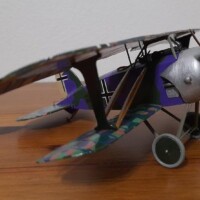Albatros D.XI, Karaya, 1:48, test pilot Lt. Heinrich Henkel, Jasta 37, 8 victories
I wanted to build a one off model of a lesser known aircraft type without strings, but how wrong I was. The hull was built excellently, everything fit and I only added a few details. But then I found out that five of the eleven cylinders were missing from the engine and I had to make new ones. Furthermore, the machine gun barrels were so poorly cast that I had to make new ones as well, and the machine gun casings were so crumpled that I had difficulty flattening them into a somewhat satisfactory shape. But then I found out that for the upper wing the left half is almost paper thin and the right half is 3mm thick. So I used a spare wing from an Albatros D. III and then just cut and sanded. Fortunately, the wings were fine, so I supplied them from the kit. If someone is going to build, I recommend that they thoroughly check all the parts in the kit, which I did not do.
The Albatros D XI was the first of the Albatros D series to use a rotary engine and was fitted with a powerful 160 hp Siemens-Halske Sh III geared engine. This engine was installed in a horseshoe-shaped housing with a pointed "elephant". -ear extensions at the back. These acted as venturi tubes and aided cooling by drawing air through the fairing, which also reduced drag.
Two prototypes were built, the first with a four-bladed propeller and balanced parallel-chord ailerons, and the second machine with unbalanced inverse-cone ailerons and a two-bladed propeller. Hollow wooden I struts reinforced the wings. The flight and landing loads were carried by two hollow diagonal struts, which dispensed with the need for wire bracing. Both aircraft featured a plywood box fuselage with a built-in fin, the rest of the aircraft was covered in fabric.
Initially flown in February 1918, the D XIs took part in the second D-type competition. Remarkable climb performance was noted, but no production order was placed. Span, 8.0 m. (26 ft. 3 in.). Length 5.58m. (18 ft 3 3/4 in). Height 2.86m. (9 ft 4 5/8 in). Area, 18.5 m2. (199.8 square feet). Weights: Empty, 494 kg. (1,087 lbs.). Loaded, 689 kg. (1,516 lb). Speed, 190 km.h. (118.75 mph). Climb (D Comp. at loaded weight 723 kg.), 15,000 m. (16,400 ft.) in 151 min. Length, 1.5 hours. Armament, two Spandau machine guns.
Albatros D.XI 2208/18, considered an "interesting type", was entered in the third fighter competition despite being powered by a Siemens-Halske rotary engine. The shorter undercarriage legs made possible by the four-blade propeller made this aircraft easier to land than the Albatros D.XI 2209/18. The D.XI prototypes were very compact, but the roll rate was too low for a successful fighter, probably due to the close proximity of the wing spars required for the I-struts. This would reduce the torsional stiffness of the wing, causing it to twist in the opposite direction of aileron application. Despite the good flight characteristics demonstrated at the third fighter competition, the Albatros D.XI 2208/18 had too slow a turn rate, critical fighter capability and excellent fighters were available.
Both prototypes were flown for the Albatros factory by fighter ace Lt. Heinrich Henkel. Henkel was born in Hamburg, German Empire on 11 May 1896.
On September 1, 1914, Henkel volunteered for military service in the Reserve Rifle Artillery Regiment Nr. 3. He went with them to battle at Nancy in France, at Antwerp and at Ypres. On July 1, 1915, he was transferred to the infantry. He was wounded in action on 25 September 1916. He was subsequently promoted to the officer ranks as Leutnant in December 1916. He volunteered for air service and in February 1917 began training in the Fliegerersatz-Abteilung (Replacement Detachment)
Henkel also received fighter pilot training at Valenciennes, France, before joining Jagdstaffel 37 in May 1918. He scored his first aerial victory on 9 July and scored seven more by 31 October 1918. Three of his eight victories were shot down. observation balloons, making it a "balloon buster". Heinrich Henkel survived the war, was awarded the Iron Cross for his bravery, but fell into obscurity.











Great build and interesting write-up, Milan...thanks for sharing!
Thank you Joe.
That’s really nice, Milan! I had no idea that a 1/48 kit of this plane existed. I built a 1/72 vac form D.XI way back in the 80s. I think it was a Formaplane or Joystick product.
Thank you John.
Excellent build and a great article, Milan @milantesar
You don't see that much WWI aircraft with a four blade propellor.
Thank you John.
If you hadn't included that photograph at the end, I would have said this should be published on April 1.
Nice work on what is obviously from your description one of the "lesser" kits out there, and a solid result.
Thank you Tom.
Very nice work, Milan. @milantesar
Thank you John.
Excellent build and post about a relatively obscure aircraft. And pilot.
Thank you Chas.
Very nice!
Thank you Robert.
Fantastic job, Milan, on a very challenging kit! You overcame all obstacles the kit posed you in a most excellent manner. Superb write-up, too!
Thank you Spiros.
Once again an excellent build Milan, especially in overcoming the kit problems. Great narrative to go with the photos.
Thank you Ian.
Great job on an interesting subject, Milan.
Thank you Gary.
Yet another WW1 masterpiece from you, Milan, a good save on the missing and damaged parts.
Thank you George.